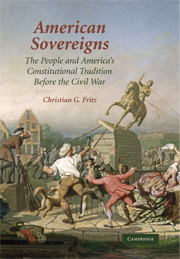PART TWO - THE SOVEREIGN BEHIND THE FEDERAL CONSTITUTION
Published online by Cambridge University Press: 31 January 2011
Summary
After Independence, the authority of the people conferred legitimacy on the governments established by America's written constitutions, ensuring that the sovereign source of the federal Constitution became (and remained) an issue of prime importance. In fact, against the prevailing assumption that sovereignty was indivisible, the Federalist defense of the proposed constitutional structure rested on the authority of the collective sovereign.
As the sovereign, the people could divide and allocate powers as they wished between state and national governments while retaining their ultimate authority as the sovereign. Invoking the sovereignty of the people was crucial to the formation of a national government that replaced the Articles of Confederation. But unlike the state constitutions, it proved a more elusive task to identify the sovereign that authorized the federal Constitution.
Framers of the federal Constitution were more successful in harnessing the authority of the collective sovereign to establish a new national government than they were in restraining wide-ranging constitutional ideas about the role of the people after the formation of governments. A decade's experience with written constitutions produced different possibilities about the relationship between the people and their governments. Supporters of the federal Constitution hoped its formation would establish a constitutional order after which little would be heard of the sovereign people except in an attenuated, symbolic, and theoretical sense. Early experience with that constitution, however, proved otherwise.
- Type
- Chapter
- Information
- American SovereignsThe People and America's Constitutional Tradition Before the Civil War, pp. 117 - 118Publisher: Cambridge University PressPrint publication year: 2007

